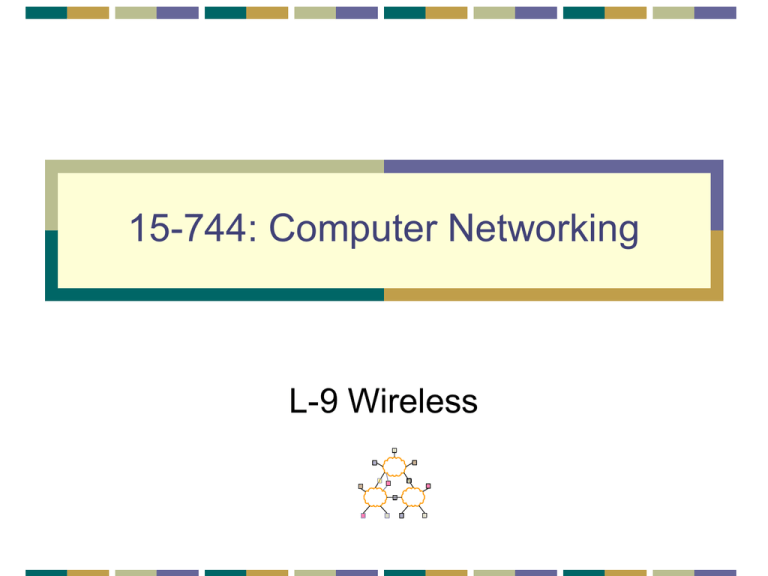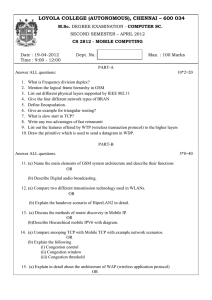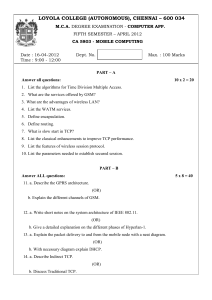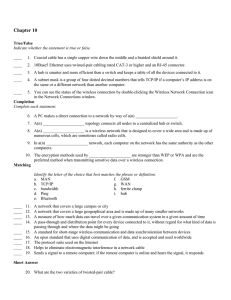15-744: Computer Networking L-9 Wireless
advertisement

15-744: Computer Networking L-9 Wireless Wireless Intro • TCP on wireless links • Wireless MAC • Assigned reading • [BPSK97] A Comparison of Mechanism for Improving TCP Performance over Wireless Links • [BDS+94] MACAW: A Media Access Protocol for Wireless LAN’s 2 Wireless Challenges • Force us to rethink many assumptions • Need to share airwaves rather than wire • Don’t know what hosts are involved • Host may not be using same link technology • Mobility • Other characteristics of wireless • Noisy lots of losses • Slow • Interaction of multiple transmitters at receiver • Collisions, capture, interference • Multipath interference 3 Overview • Wireless Background • Wireless MAC • MACAW • 802.11 • Wireless TCP 4 Transmission Channel Considerations • Every medium supports transmission in a certain frequency range. Good Bad • Outside this range, effects such as attenuation, .. degrade the signal too much • Transmission and receive hardware will try to maximize the useful bandwidth in this frequency band. • Tradeoffs between cost, distance, bit rate Frequency • As technology improves, these parameters change, even for the same wire. • Thanks to our EE friends Signal 5 The Nyquist Limit • A noiseless channel of width H can at most transmit a binary signal at a rate 2 x H. • E.g. a 3000 Hz channel can transmit data at a rate of at most 6000 bits/second • Assumes binary amplitude encoding 6 Past the Nyquist Limit • More aggressive encoding can increase the channel bandwidth. • Example: modems • Same frequency - number of symbols per second • Symbols have more possible values psk Psk + AM 7 Capacity of a Noisy Channel • Can’t add infinite symbols - you have to be able to tell them apart. This is where noise comes in. • Shannon’s theorem: • • • • C = B x log(1 + S/N) C: maximum capacity (bps) B: channel bandwidth (Hz) S/N: signal to noise ratio of the channel • Often expressed in decibels (db). 10 log(S/N). • Example: • Local loop bandwidth: 3200 Hz • Typical S/N: 1000 (30db) • What is the upper limit on capacity? • Modems: Teleco internally converts to 56kbit/s digital signal, which sets a limit on B and the S/N. 8 Free Space Loss Loss = Pt / Pr = (4p d)2 / (Gr Gt l2) • Loss increases quickly with distance (d2). • Need to consider the gain of the antennas at transmitter and receiver. • Loss depends on frequency: higher loss with higher frequency. • But careful: antenna gain depends on frequency too • For fixed antenna area, loss decreases with frequency • Can cause distortion of signal for wide-band signals 9 Cellular Reuse • Transmissions decay over distance • Spectrum can be reused in different areas • Different “LANs” • Decay is 1/R2 in free space, 1/R4 in some situations 10 Multipath Effects • Receiver receives multiple copies of the signal, each following a different path • Copies can either strengthen or weaken each other. • Depends on whether they are in our out of phase • Small changes in location can result in big changes in signal strength. • Short wavelengths, e.g. 2.4 GHz 12 cm • Difference in path length can cause inter-symbol interference (ISI). 11 Fading - Example • Frequency of 910 MHz or wavelength of about 33 cm 12 Overview • Wireless Background • Wireless MAC • MACAW • 802.11 • Wireless TCP 13 Medium Access Control • Think back to Ethernet MAC: • Wireless is a shared medium • Transmitters interfere • Need a way to ensure that (usually) only one person talks at a time. • Goals: Efficiency, possibly fairness 14 Example MAC Protocols • Pure ALOHA • Transmit whenever a message is ready • Retransmit when ACK is not received • Slotted ALOHA • • • • Time is divided into equal time slots Transmit only at the beginning of a time slot Avoid partial collisions Increase delay, and require synchronization • Carrier Sense Multiple Access (CSMA) • Listen before transmit • Transmit only when no carrier is detected 15 CSMA/CD Does Not Work • Carrier sense problems • Relevant contention at the receiver, not sender • Hidden terminal • Exposed terminal • Collision detection problems • Hard to build a radio that can transmit and receive at same time Hidden A B C Exposed A B C D 16 MACAW • 4 design details 1. 2. 3. 4. Contention is at the receiver Congestion is location dependent Fairness through learning of congestion levels Propagate synchronization information about contention periods 17 Fairness in MACAW • Channel capture in MACA • Backoff doubled every collision • Reduce backoff on success • Solution: Copy backoffs • This does not always work as wanted 18 MACAW: Additional Design • Multiple Stream Model • ACK (TCP transfer!) 19 MACAW: Additional Design • DS • Because carrier sense disabled RTS CTS DS DATA Hears RTS Doesn’t hear CTS Hears DS 20 RRTS • Problem: RTS Backoff Increases RTS RRTS ACK RTS DATA RTS DS prevents P2 from respond Cannot send CTS RRTS CTS X RTS lost DS DATA RTS CTS 21 MACAW: Conclusions • 8% extra overhead for DS and ACK • 37% improvement in congestion • Future work: • Multicast support • Copying backoff 22 Overview • Wireless Background • Wireless MAC • MACAW • 802.11 • Wireless TCP 23 IEEE 802.11 Overview • Adopted in 1997 Defines: • MAC sublayer • MAC management protocols and services • Physical (PHY) layers • IR • FHSS • DSSS 24 802.11 particulars • 802.11b (WiFi) • Frequency: 2.4 - 2.4835 Ghz DSSS • Modulation: DBPSK (1Mbps) / DQPSK (faster) • Orthogonal channels: 3 • There are others, but they interfere. (!) • Rates: 1, 2, 5.5, 11 Mbps • 802.11a: Faster, 5Ghz OFDM. Up to 54Mbps • 802.11g: Faster, 2.4Ghz, up to 54Mbps 25 802.11 details • Fragmentation • 802.11 can fragment large packets (this is separate from IP fragmentation). • Preamble • 72 bits @ 1Mbps, 48 bits @ 2Mbps • Note the relatively high per-packet overhead. • Control frames • RTS/CTS/ACK/etc. • Management frames • Association request, beacons, authentication, etc. 26 Overview, 802.11 Architecture ESS Existing Wired LAN AP STA BSS AP STA STA BSS STA Infrastructure Network STA Ad Hoc Network STA BSS BSS STA Ad Hoc Network STA BSS: Basic Service Set ESS: Extended Service Set 27 802.11 modes • Infrastructure mode • All packets go through a base station • Cards associate with a BSS (basic service set) • Multiple BSSs can be linked into an Extended Service Set (ESS) • Handoff to new BSS in ESS is pretty quick • Wandering around CMU • Moving to new ESS is slower, may require readdressing • Wandering from CMU to Pitt • Ad Hoc mode • Cards communicate directly. • Perform some, but not all, of the AP functions 28 802.11 Management Operations • • • • Scanning Association/Reassociation Time synchronization Power management 29 Scanning & Joining • Goal: find networks in the area • Passive scanning • No require transmission saves power • Move to each channel, and listen for Beacon frames • Active scanning • Requires transmission saves time • Move to each channel, and send Probe Request frames to solicit Probe Responses from a network • Joining a BSS • Synchronization in TSF and frequency : Adopt PHY parameters : The BSSID : WEP : Beacon Period : DTIM 30 Association in 802.11 1: Association request 2: Association response 3: Data traffic Client AP 31 Time Synchronization in 802.11 • Timing synchronization function (TSF) • AP controls timing in infrastructure networks • All stations maintain a local timer • TSF keeps timer from all stations in sync • Periodic Beacons convey timing • Beacons are sent at well known intervals • Timestamp from Beacons used to calibrate local clocks • Local TSF timer mitigates loss of Beacons 32 Power Management in 802.11 • A station is in one of the three states • Transmitter on • Receiver on • Both transmitter and receiver off (dozing) • AP buffers packets for dozing stations • AP announces which stations have frames buffered in its Beacon frames • Dozing stations wake up to listen to the beacons • If there is data buffered for it, it sends a poll frame to get the buffered data 33 IEEE 802.11 Wireless MAC • Support broadcast, multicast, and unicast • Uses ACK and retransmission to achieve reliability for unicast frames • No ACK/retransmission for broadcast or multicast frames • Distributed and centralized MAC access • Distributed Coordination Function (DCF) • Point Coordination Function (PCF) 34 802.11 DCF (CSMA) • • • • • Distributed Coordination Function (CSMA/CA) Sense medium. Wait for a DIFS (50 µs) If busy, wait ‘till not busy. Random backoff. If not busy, Tx. Backoff is binary exponential • Acknowledgements use SIFS (short interframe spacing). 10 µs. • Short spacing makes exchange atomic 802.11 DCF (RTS/CTS) 36 Discussion • RTS/CTS/Data/ACK vs. Data/ACK • Why/when is it useful? • What is the right choice • Why is RTS/CTS not used? 37 Overview • Wireless Background • Wireless MAC • MACAW • 802.11 • Wireless TCP 38 Wireless Challenges • Force us to rethink many assumptions • Need to share airwaves rather than wire • Don’t know what hosts are involved • Host may not be using same link technology • Mobility • Other characteristics of wireless • Noisy lots of losses • Slow • Interaction of multiple transmitters at receiver • Collisions, capture, interference • Multipath interference 39 TCP Problems Over Noisy Links • Wireless links are inherently error-prone • Fades, interference, attenuation • Errors often happen in bursts • TCP cannot distinguish between corruption and congestion • TCP unnecessarily reduces window, resulting in low throughput and high latency • Burst losses often result in timeouts • Sender retransmission is the only option • Inefficient use of bandwidth 40 Constraints & Requirements • Incremental deployment • Solution should not require modifications to fixed hosts • If possible, avoid modifying mobile hosts • Probably more data to mobile than from mobile • Attempt to solve this first 41 Challenge #1: Wireless Bit-Errors Router Computer 1 Computer 2 Loss Congestion 3 2 22 1 0 Loss Congestion Wireless Burst losses lead to coarse-grained timeouts Result: Low throughput 42 Performance Degradation Sequence number (bytes) 2.0E+06 Best possible TCP with no errors (1.30 Mbps) 1.5E+06 TCP Reno (280 Kbps) 1.0E+06 5.0E+05 0.0E+00 0 10 20 30 40 50 60 Time (s) 2 MB wide-area TCP transfer over 2 Mbps Lucent WaveLAN 43 Proposed Solutions • End-to-end protocols • Selective ACKs, Explicit loss notification • Split-connection protocols • Separate connections for wired path and wireless hop • Reliable link-layer protocols • Error-correcting codes • Local retransmission 44 Approach Styles (End-to-End) • Improve TCP implementations • Not incrementally deployable • Improve loss recovery (SACK, NewReno) • Help it identify congestion (ELN, ECN) • ACKs include flag indicating wireless loss • Trick TCP into doing right thing E.g. send extra dupacks • What is SMART? • DUPACK includes sequence of data packet that triggered it Wired link Wireless link 45 Approach Styles (Split Connection) • Split connections • Wireless connection need not be TCP • Hard state at base station • Complicates mobility • Vulnerable to failures • Violates end-to-end semantics Wired link Wireless link 46 Congestion Window (bytes) Split-Connection Congestion Window 60000 Wired connection Wireless connection 50000 40000 30000 20000 10000 0 0 20 40 60 80 100 120 Time (sec) • Wired connection does not shrink congestion window • But wireless connection times out often, causing sender to stall 47 Approach Styles (Link Layer) • More aggressive local rexmit than TCP • Bandwidth not wasted on wired links • Adverse interactions with transport layer • Timer interactions • Interactions with fast retransmissions • Large end-to-end round-trip time variation • FEC does not work well with burst losses Wired link Wireless link ARQ/FEC 48 Hybrid Approach: Snoop Protocol • Shield TCP sender from wireless vagaries • Eliminate adverse interactions between protocol layers • Congestion control only when congestion occurs • The End-to-End Argument [SRC84] • Preserve TCP/IP service model: end-to-end semantics • Is connection splitting fundamentally important? • Eliminate non-TCP protocol messages • Is link-layer messaging fundamentally important? Fixed to mobile: transport-aware link protocol Mobile to fixed: link-aware transport protocol 49 Snoop Overview • Modify base station • to cache un-acked TCP packets • … and perform local retransmissions • Key ideas • No transport level code in base station • When node moves to different base station, state eventually recreated there 50 Snoop Protocol: CH to MH 4 3 2 1 Snoop Agent 6 5 Correspondent Host 1 Base Station Mobile Host • Snoop agent: active interposition agent • Snoops on TCP segments and ACKs • Detects losses by duplicate ACKs and timers • Suppresses duplicate ACKs from MH 51 Snoop Protocol: CH to MH Snoop Agent 65 3 2 4 1 Correspondent Host Base Station Mobile Host • Transfer of file from CH to MH • Current window = 6 packets 52 Snoop Protocol: CH to MH 65 Snoop Agent 4 3 Correspondent Host 2 1 Base Station Mobile Host • Transfer begins 53 Snoop Protocol: CH to MH 4 3 2 1 6 5 Correspondent Host Snoop Agent 1 Base Station Mobile Host • Snoop agent caches segments that pass by 54 Snoop Protocol: CH to MH 4 3 2 1 6 5 Correspondent Host Snoop Agent 3 2 1 Base Station Mobile Host 1 Lost Packets • Packet 1 is Lost 55 Snoop Protocol: CH to MH 5 4 3 2 1 6 Snoop Agent 4 3 2 ack 0 Correspondent Host Base Station Mobile Host 1 Lost Packets • Packet 1 is Lost • Duplicate ACKs generated 56 Snoop Protocol: CH to MH 6 5 4 3 2 1 Snoop Agent 6 5 1 4 3 2 ack 0 Correspondent Host Base Station ack 0 Mobile Host 1 Lost Packets • Packet 1 is Lost • Duplicate ACKs generated • Packet 1 retransmitted from cache at higher priority 57 Snoop Protocol: CH to MH 6 5 4 3 2 1 Snoop Agent 6 5 1 4 3 2 ack 4 Correspondent Host Base Station ack 0 Mobile Host X • Duplicate ACKs suppressed 58 Snoop Protocol: CH to MH 6 5 Snoop Agent 6 5 1 4 3 2 ack 5 Correspondent Host Base Station Mobile Host ack 4 • Clean cache on new ACK 59 Snoop Protocol: CH to MH 6 ack 4 Correspondent Host Snoop Agent 6 51 4 3 2 ack 6 Base Station Mobile Host ack 5 • Clean cache on new ACK 60 Snoop Protocol: CH to MH Snoop Agent 9 8 Correspondent Host ack 5 7 Base Station ack 6 6 51 4 3 2 Mobile Host • Active soft state agent at base station • Transport-aware reliable link protocol • Preserves end-to-end semantics 61 Performance: FH to MH 1.6 1.4 Throughput (Mbps) Snoop+SACK 1.2 Snoop 1 SPLIT-SACK Typical error rates TCP SACK 0.8 SPLIT 0.6 TCP Reno 0.4 • Snoop+SACK and Snoop perform best • Connection splitting not essential • TCP SACK performance disappointing 0.2 0 0 500 1000 1500 2000 2500 1/Bit-error Rate (1 error every x Kbits) 2 MB local-area TCP transfer over 2 Mbps Lucent WaveLAN 62 Discussion • Real link-layers aren’t windowed • Out of order delivery not that significant a concern • TCP timers are very conservative 63



